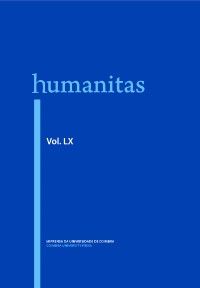Please use this identifier to cite or link to this item:
https://hdl.handle.net/10316.2/27920| DC Field | Value | Language |
|---|---|---|
| dc.contributor.author | Barbosa, Tereza Virgínia Ribeiro | - |
| dc.date.accessioned | 2014-01-21T16:08:10Z | |
| dc.date.accessioned | 2020-10-02T17:02:12Z | - |
| dc.date.available | 2014-01-21T16:08:10Z | |
| dc.date.available | 2020-10-02T17:02:12Z | - |
| dc.date.issued | 2008 | - |
| dc.identifier.issn | 2183-1718 | - |
| dc.identifier.uri | https://hdl.handle.net/10316.2/27920 | - |
| dc.description.abstract | Pretendemos mostrar a personificação do espaço em um drama satírico de Sófocles. Focalizaremos as grutas e as ninfas e discutiremos o espaço dedicado a estas deidades ocupando-nos particularmente dos versos 267-8 de Ichneutas e postulando que a leitura que subentenda a personificação provoca ambiguidade e riso. A fusão de imagens das ninfas, grutas e mulheres usada por outros autores, nessa tentativa, argumentarão a nosso favor. O autor escolhido para exemplificação juntamente com Sófocles é o romancista brasileiro, Érico Veríssimo em Incidente em Antares. | por |
| dc.description.abstract | In this article, we intend to show the personification of space in a Sophocles' satyr play and try to focus on the personification of nymphs in caves. Specifically verses 267-8 of Ichneutae are analyzed; we propose that the poet's finality is to provoke laugh. The fusion of images of nymphs, caves and women is used by other authors and help us in our attempt to affirm that the same strategy is used in a Brazilian novel, Incidente em Antares, of Érico Veríssimo. | eng |
| dc.language.iso | por | - |
| dc.publisher | Faculdade de Letras da Universidade de Coimbra, Instituto de Estudos Clássicos | - |
| dc.subject | Nymphs | eng |
| dc.subject | Cave | eng |
| dc.subject | Nature | eng |
| dc.subject | Women | eng |
| dc.subject | Ninfas | por |
| dc.subject | Gruta | por |
| dc.subject | Natureza | por |
| dc.subject | Mulher | por |
| dc.title | Representações do feminino no drama satírico: as ninfas, amenas e sombrias | por |
| dc.type | article | - |
| uc.publication.collection | Humanitas vol. 60 | - |
| uc.publication.firstPage | 75 | - |
| uc.publication.lastPage | 86 | - |
| uc.publication.location | Coimbra | - |
| uc.publication.journalTitle | Humanitas | - |
| uc.publication.volume | 60 | por |
| dc.identifier.doi | 10.14195/2183-1718_60_6 | - |
| uc.publication.section | Artigos | - |
| uc.publication.orderno | 6 | - |
| uc.publication.area | Artes e Humanidades | - |
| uc.publication.manifest | https://dl.uc.pt/json/iiif/10316.2/27920/257227/manifest?manifest=/json/iiif/10316.2/27920/257227/manifest | - |
| uc.publication.thumbnail | https://dl.uc.pt/retrieve/11998668 | - |
| item.grantfulltext | open | - |
| item.fulltext | With Fulltext | - |
| Appears in Collections: | HVMANITAS | |
Files in This Item:
| File | Description | Size | Format | |
|---|---|---|---|---|
| humanitas60_artigo6.pdf | 5.01 MB | Adobe PDF |  |
Items in DSpace are protected by copyright, with all rights reserved, unless otherwise indicated.
